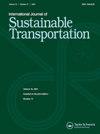市区以外:影响低收入郊区功利和休闲骑行的因素
IF 3.1
3区 工程技术
Q2 ENVIRONMENTAL STUDIES
International Journal of Sustainable Transportation
Pub Date : 2023-01-01
DOI:10.1080/15568318.2022.2091496
引用次数: 2
摘要
与许多城市一样,实用自行车是多伦多气候战略的一部分。为了使这一策略发挥作用,自行车必须遍布整个城市,然而,尽管大多数城市适合的短途旅行(60%)发生在郊区,郊区居民骑自行车的交通方式远少于市中心居民,而市中心有大多数自行车基础设施。尽管如此,郊区的一些人骑自行车出行,但很少有研究关注郊区的自行车。这对健康、气候和平等具有重要影响。本文采用广义结构方程模型分析了一个低收入郊区居民的功利性和娱乐性自行车骑行的影响因素(n = 215)。主成分分析用于开发潜在态度变量。最能预测功利骑行的因素是休闲骑行的频率、自行车拥有量、认识骑自行车的人、是男性以及拥有较少的汽车。最能预测休闲骑自行车的因素是拥有自行车、认识骑自行车的人、知道去哪里维修、以及对健康和安全的态度。功利骑行对休闲骑行的频率没有影响。潜在态度变量均不影响功利骑行。然而,在消费和盗窃方面得分较高的受访者更有可能生活在低收入家庭。高收入家庭在健康和安全变量上得分更高。结果表明,团体骑行、获得自行车和维修以及与骑自行车的人见面的方式可能是增加郊区社区功利骑行的有效干预措施。本文章由计算机程序翻译,如有差异,请以英文原文为准。
Beyond downtown: factors influencing utilitarian and recreational cycling in a low-income suburb
Abstract As in many cities, utilitarian cycling is part of Toronto’s climate strategy. For this tactic to work, cycling must occur throughout the city, yet despite most of the city’s suitable short trips (60%) occurring in the suburbs, suburban residents cycle far less for transport than downtown residents where most cycling infrastructure is found. Nonetheless, some people in suburban areas cycle for transport, but little research focuses on suburban cycling. This has important implications for health, climate and equity. We used generalized structural equation modeling to analyze data from a survey of factors influencing utilitarian and recreational cycling among residents of a lower-income auto-oriented suburb lacking utilitarian cycling infrastructure (n = 215). Principal component analysis was used to develop latent attitudinal variables. The strongest predictors of utilitarian cycling were the frequency of recreational cycling, bike ownership, knowing people who bike, being male, and owning fewer cars. The strongest predictors of recreational cycling were bicycle ownership, knowing people who bike, knowing where to access repairs, and having attitudes strongly related to health and safety. Utilitarian cycling did not influence the frequency of recreational cycling. None of the latent attitudinal variables influenced utilitarian cycling. However, respondents scoring high in the expense and theft variable were more likely to live in lower income households. Those in higher income households scored higher on the health and safety variable. Results suggest group rides, access to bicycles and repairs, and ways to meet people who bike may be useful interventions to increase utilitarian cycling in suburban communities.
求助全文
通过发布文献求助,成功后即可免费获取论文全文。
去求助
来源期刊
CiteScore
8.90
自引率
2.60%
发文量
56
期刊介绍:
The International Journal of Sustainable Transportation provides a discussion forum for the exchange of new and innovative ideas on sustainable transportation research in the context of environmental, economical, social, and engineering aspects, as well as current and future interactions of transportation systems and other urban subsystems. The scope includes the examination of overall sustainability of any transportation system, including its infrastructure, vehicle, operation, and maintenance; the integration of social science disciplines, engineering, and information technology with transportation; the understanding of the comparative aspects of different transportation systems from a global perspective; qualitative and quantitative transportation studies; and case studies, surveys, and expository papers in an international or local context. Equal emphasis is placed on the problems of sustainable transportation that are associated with passenger and freight transportation modes in both industrialized and non-industrialized areas. All submitted manuscripts are subject to initial evaluation by the Editors and, if found suitable for further consideration, to peer review by independent, anonymous expert reviewers. All peer review is single-blind. Submissions are made online via ScholarOne Manuscripts.

 求助内容:
求助内容: 应助结果提醒方式:
应助结果提醒方式:


